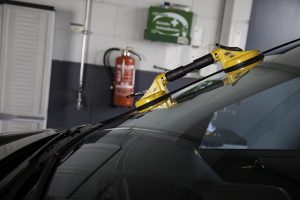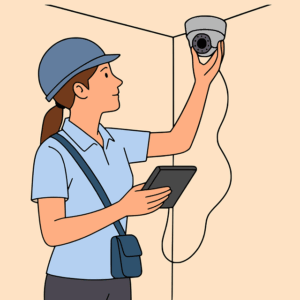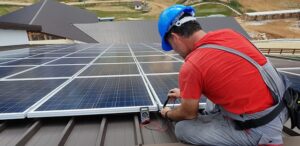Maximizing HVAC Efficiency: A Guide to Insulating Your Units for Optimal Performance
Insulation significantly enhances HVAC performance by acting as a thermal barrier, reducing the impact of external temperatures on HVAC systems and minimizing their workload. Effective insulation leads to more stable indoor conditions, less frequent need for HVAC repairs due …….

Insulation significantly enhances HVAC performance by acting as a thermal barrier, reducing the impact of external temperatures on HVAC systems and minimizing their workload. Effective insulation leads to more stable indoor conditions, less frequent need for HVAC repairs due to decreased wear and tear, and improved energy efficiency, which translates into cost savings and a reduced carbon footprint. Strategic insulation upgrades are advised as a long-term maintenance strategy for HVAC systems, offering comfort, longevity, and energy savings.
High-quality insulation materials like closed-cell spray foam and reflective foil insulation can further improve system efficiency by preventing heat transfer and air leaks. Properly insulating HVAC units involves precise measurement, selection of the right material, and sealing with weather-resistant sealant to maintain effectiveness and prevent moisture ingress. In high humidity regions, a vapor barrier is recommended. Regular maintenance checks are crucial for maintaining insulation integrity and ensuring long-term energy savings and system performance. Remember, optimal HVAC performance relies on proper insulation and regular HVAC repair services to address any issues promptly.
In the pursuit of energy efficiency and cost savings, the role of effective insulation in HVAC systems cannot be overstated. This comprehensive article delves into optimizing HVAC efficiency by strategically installing insulation around units, a practice that significantly enhances system performance. We explore the necessary assessments to determine your HVAC unit’s insulation needs, the types of insulation most effective for these critical systems, and a detailed guide on their installation. Discover the multitude of benefits that come with properly insulated HVAC units in both residential and commercial settings, including cost-effective solutions for home and business HVAC systems. Learn about expert maintenance tips to ensure your system’s insulation remains effective over time, understand the importance of R-value in maintaining efficient operation, and explore how long-term savings make this investment a valuable upgrade. Through case studies and guidance on choosing the right contractor, we guide you towards achieving an eco-friendly approach to HVAC repair and maintenance, ultimately reducing environmental impact while enhancing system performance.
- Optimizing HVAC Efficiency with Strategic Insulation Installation
- The Role of Insulation in Enhancing HVAC System Performance
- Assessing Your HVAC Unit's Insulation Needs for Maximum Efficiency
- Types of Insulation Best Suited for HVAC Units
- Step-by-Step Guide to Installing Insulation Around Your HVAC Units
Optimizing HVAC Efficiency with Strategic Insulation Installation

To enhance the performance and efficiency of heating, ventilation, and air conditioning (HVAC) systems, strategic insulation installation plays a pivotal role. Properly insulating units within buildings serves as a barrier against extreme temperatures, reducing the strain on HVAC systems during operation. This insulative measure acts as a thermal blanket, maintaining consistent indoor temperatures and ensuring that the HVAC system does not work overtime to achieve comfort levels. As a result, the need for frequent HVAC repair is significantly diminished, as the system experiences less wear and tear. Moreover, the energy consumption of HVAC systems is optimized, leading to cost savings and a reduced carbon footprint due to more efficient energy usage. Homeowners and facility managers should consider insulation upgrades as part of their routine maintenance to maximize the lifespan and efficiency of their HVAC systems. It’s a cost-effective investment that yields dividends in terms of comfort, durability, and energy savings over time.
The Role of Insulation in Enhancing HVAC System Performance

Incorporating insulation around units is a pivotal strategy in optimizing the efficiency of Heating, Ventilation, and Air Conditioning (HVAC) systems. Effective insulation acts as a barrier against extreme temperatures, reducing the workload on HVAC equipment. During hot months, it prevents excessive heat from penetrating and causing the system to overwork to maintain desired indoor temperatures. Conversely, in colder seasons, it shields the units from freezing conditions, thereby preventing damage and prolonging their lifespan. The thermal resistance properties of insulation ensure that conditioned air remains inside where it is needed most, leading to less energy consumption and lower utility bills. Regular maintenance and timely HVAC repair are complementary measures to this insulation approach, as they together enhance system performance and longevity, contributing significantly to energy conservation efforts. Homeowners looking to improve their HVAC system’s efficiency should consider the strategic placement of insulation a crucial investment in their property’s overall comfort and energy efficiency.
Assessing Your HVAC Unit's Insulation Needs for Maximum Efficiency

When looking to enhance the efficiency of your HVAC system, assessing the insulation around your units is a critical step. Proper insulation not only preserves the temperature-controlled air within your space but also reduces the strain on your HVAC system. To determine whether your HVAC unit’s insulation meets the standards for maximum efficiency, start by examining the current R-value of the existing insulation. The R-value indicates the material’s resistance to heat flow and should align with the recommendations specific to your region’s climate and the type of fuel used by your heating system. For optimal performance, ensure that insulation is evenly distributed without any gaps or openings where warm or cool air could escape. Regular HVAC repair services can also assist in identifying any leaks or breaches in the insulation, which, if left unaddressed, could significantly diminish your system’s effectiveness. Additionally, consider the condition of ductwork and whether it is adequately sealed and insulated to prevent energy loss. In some cases, upgrading to higher R-value materials may be necessary, especially for older systems or those in poorly insulated areas. Regularly maintaining and inspecting your HVAC system’s insulation is essential for sustained efficiency and can lead to noticeable savings on your utility bills. It’s a prudent measure that complements any HVAC repair work you might undertake to keep your system running smoothly and efficiently.
Types of Insulation Best Suited for HVAC Units

When it comes to optimizing the efficiency of HVAC units, proper insulation plays a pivotal role in maintaining desired temperatures and reducing energy consumption. The choice of insulation material is crucial for safeguarding against extreme weather conditions and ensuring the longevity of the HVAC system. Among the best-suited types of insulation for HVAC units are closed-cell spray foam, fiberglass batting, and reflective foil insulation.
Closed-cell spray foam is an excellent option for insulating around HVAC units due to its high R-value, which resists heat flow very well. It expands to fill all gaps and cracks, creating an effective seal that prevents conditioned air from escaping and outside air from entering. This not only enhances system efficiency but also minimizes the strain on the HVAC system, potentially reducing the need for frequent HVAC repair services. Fiberglass batting is another viable option, offering a cost-effective solution with moderate R-values. It should be installed properly to avoid air leaks, ensuring consistent performance and energy savings. Reflective foil insulation, particularly when used in conjunction with other materials like fiberglass, reflects heat away from the unit, further improving its efficiency and reducing the demand for HVAC repair due to wear and tear related to overworked systems. Each of these materials contributes to a more energy-efficient system, leading to lower utility bills and a more comfortable environment.
Step-by-Step Guide to Installing Insulation Around Your HVAC Units

When aiming to enhance the efficiency of your HVAC system, proper insulation is key. Insulating around your HVAC units is a critical step in maintaining energy consumption and ensuring optimal performance. To effectively install insulation around your HVAC units, follow these detailed steps.
Begin by turning off all power sources connected to your HVAC unit before starting any physical work. Safety should always be the utmost priority when handling electrical components or working on an HVAC system. Next, measure the area that requires insulation, ensuring you account for all sides and spaces around the unit. Select an appropriate type of insulation material; foam boards, fiberglass batts, or reflective radiant barriers are common choices depending on the environment and specific needs.
Once you have your materials, cut the insulation to fit snugly against each side of the HVAC unit. Carefully apply a weather-resistant barrier or sealant around the edges to prevent moisture intrusion and air leaks. This step is crucial for maintaining the integrity of the insulation and the efficiency of your HVAC system. After sealing the edges, secure the insulation in place with adhesive or fasteners that are compatible with your unit’s material. Ensure there are no gaps or openings where air could escape or enter.
For added protection, consider using a vapor barrier if your climate is prone to high humidity levels. This will help prevent condensation from forming within the insulation, which could lead to rust or corrosion around the unit. Finally, once all sides are securely covered and sealed, you can power up your HVAC system and immediately notice a difference in its efficiency. Regular maintenance and checks should be part of your ongoing routine to ensure the insulation remains effective over time, contributing to energy savings and prolonging the lifespan of your HVAC equipment. Remember to consider local building codes and regulations before beginning any installation to ensure compliance and safety.
In wrapping up our exploration of the subject, it’s clear that installing insulation around HVAC units is a pivotal step in optimizing their efficiency. The strategic placement of insulation acts as a barrier against external elements, thereby protecting and enhancing the performance of these systems. By addressing the specific insulation needs of each unit, homeowners can significantly reduce energy consumption and lower repair costs associated with HVAC components. The comprehensive guide provided illuminates the types of insulation most effective for various HVAC units, ensuring that readers can implement these improvements confidently. With this knowledge in hand, individuals are now better equipped to make informed decisions regarding their HVAC systems, leading to improved comfort, energy savings, and a notable reduction in the need for HVAC repair services.







